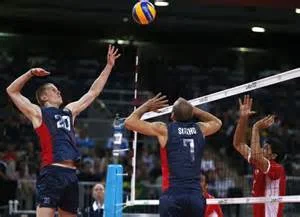Back Pain with Volleyball Serving or Hitting? Look at Shoulder Function for Possible Cause
Whether you are a junior level or even an Olympic caliber volleyball player dealing with back pain during serving or hitting, chances are that shoulder mechanics are part of the problem.
Starting the serving or hitting motion requires both extension (leaning backward) and rotating or turning of the lower back in the direction of ball contact. For a right handed hitter or server, that would mean having the trunk and lower back rotate toward the right.
Dave Smith (#20) in early hitting phase shoulder position
Finishing a serve or hit requires rotation of the lower back away from the side of ball contact. Again, for that right handed hitter or server, that would mean having the trunk and lower back rotate towards the left after ball contact.
Kim Hill (#15) with late hitting phase shoulder position
This normal flow of movement puts localized stressors on the lumbar vertebrae bones that surround and protect the spinal cord in the lower back region between the rib cage and the pelvic bones.
Certain parts of these lumbar vertebrae, called the posterior elements which include the pars interarticularis, pedicles, and articular process/facet joints that are at unique risk for overload injuries due to repetitive compression forces and somewhat limited blood supplies to these regions.
Courtesy of www.studyblue.com
In medical terms, we would call pain coming from these movements extension or rotational-based lower back pain, and it thus would seem very logical then to focus evaluation and treatment on the lumbar spine mechanics themselves.
However, my experience in working with higher level volleyball players has taught me that often the dominant shoulder can be a primary contributing culprit to this extension or rotational-based back problem, so now when I evaluate any such type of back pain in a volleyball player, I start by looking at the shoulder.
There are commonly two types of shoulder tightness patterns that can lead to both shoulder problems and pain at the lumber spine.
- TIGHTNESS OF THE FRONT OF THE SHOULDER AT THE CORACOID PROCESS
The pectoralis minor, coracobrachialis and biceps short head muscles all attach to the coracoid process, which is a bone prominent coming off of the scapula.
Courtesy of fashions-cloud.com
Tightness at this attachment site can create a hunched over posture that moms always like to warn about, but also can limit the ability to raise and reach back the shoulder which provides the power needed to hit a ball at the high end of a set or the toss before serve.
If a player has limited flexibility in the front of the shoulder at the coracoid, one frequent way to compensate (or some would say, cheat) is to over-rotate at the lumbar spine in an effort to get the hitting hand far back enough to generate powerful hits or serves.
This over-rotation, while at first might allow the player to maintain high performance, may ultimately cause higher cumulative overload forces on those posterior elements of the lumbar vertebrae and those undesired stress injuries.
This condition causes pain EARLY (before ball contact) in the hitting or serving motions, and proper identification and correction of tightness at the coracoid process can lead to healthier shoulder and back function.
- TIGHTNESS OF POSTERIOR SHOULDER CAPSULE
The glenohumeral joint is the "ball and socket" joint that is surrounded by a soft tissue joint capsule.
Courtesy of heyyoungbeliever.com
Repetitive overhead motion such as hitting or serving can lead to tightness in the back of this capsule, leading to limitations in shoulder internal rotation or the follow-through phase after ball contact.
Called Glenohumeral Internal Rotation Deficit (GIRD), this tightness can lead to reduced accuracy and speed of hits/serves.
Many volleyball players will compensate (aka cheat) by increasing rotation of the lumber spine away from the side of ball after making contact, and eventually this too will place unwanted forces on those posterior elements of the lumbar vertebrae.
GIRD causes pain LATER (after ball contact) in the hitting or serving motions, and just like with anterior shoulder tightness, proper identification and correction can reduce both shoulder and back issues while allowing more high level function.
PRE-EMPTIVE PREVENTION
Volleyball players do not have to wait for the onset of back or shoulder pain to address potential problems. Fairly quick measurements of both anterior and posterior shoulder motion patterns can lead to suggestions for stretching programs, and I routinely incorporate these into pre-season or pre-participation evaluations as part of sensible injury prevention programs.





